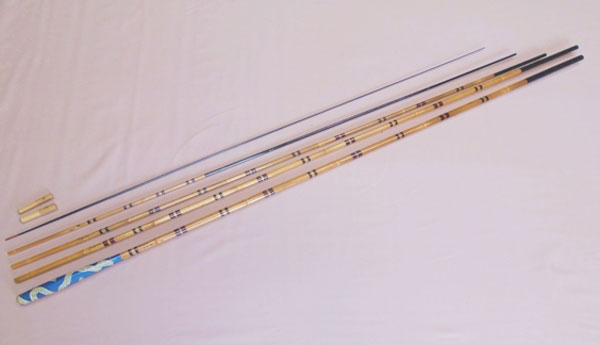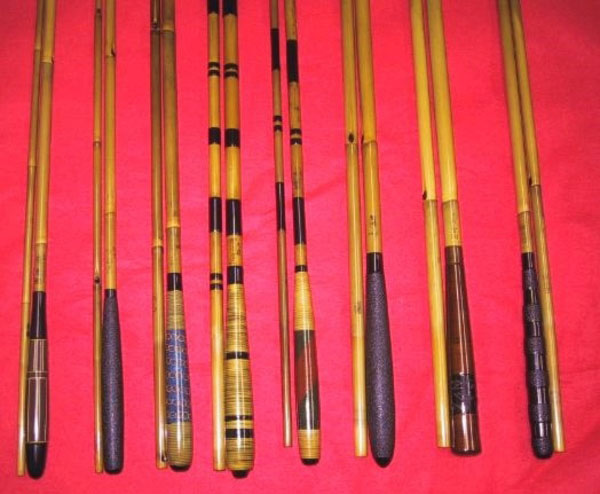
- Wood, bamboo crafts
- Wakayama
Kishu bamboo fishing rods Kishu herazao
A bamboo rod of great skill and beauty
Quietly fishing for cautious carp
Description
What is Kishu bamboo fishing rods ?
Kishu bamboo fishing rods (called Kishu herazao in Japanese) are produced in the city of Hashimoto, Wakayama prefecture for catching Japanese crucian carp. The bamboos: suzutake, madake, and yadake are cut, left to dry for several years, and only ones that pass careful examination are used.
Yadake grows abundantly in Hashimoto which is located at the foot of Mt. Koya, a major production area of suzutake, so it was natural that the production of bamboo fishing rods to catch local carp would become popular. There are one hundred and thirty steps of handiwork to make a single fishing rod, from cutting to assembly and finishing, all of which is done by one artisan. The main features of this craft are thick handles that are beautifully decorated and colored with lustrous lacquer, and the namitsugi jointing technique to prevent the rod from breaking. Rods can be made of three to five bamboo sections each measuring about ninety centimeters (thirty-five inches) in length, but there are considerable stresses and strains when catching a carp, so they must also be strong and flexible. These rods are a high-end product as they are beautifully decorated and take about six months to be produced.
History

In 1882, a master artisan in Osaka named Shoji MIZOGUCHI (Saosho I )* started making fishing rods to catch sea bream. He was well-known for inventing a production technique that involves splitting and shaving madake, a thick and hard bamboo. His eldest son, Shonosuke Mizoguchi (Saosho II), started to apprentice for him in 1907. One day Saosho II, while looking at the shaved thin bamboo splits used to prevent fabric shrinkage when washing kimono, was inspired to apply the technique to the tip end of a fishing rod. Goro TSUBAKII (Saogoro), an apprentice of Saosho II, developed a type of fishing rod in which thick and strong suzu bamboo with close nodes was used for the mid-section of the rod. Mitsuo KOJIMA (Shiko), Saogoro's apprentice, returned to the city of Hashimoto in 1931, followed in 1934 by Iwayoshi YAMADA (Genkanshi) and both became independent artisans and their techniques spread in Hashimoto. This craft has lineages of artisans and techniques that are continuously handed down from master to apprentice.
*Sasho I is his signature name to be inscribed on the rod.
Production Process
- 1. Drying the bamboo
The three varieties of bamboo are required for this craft are suzutake, madake, and yadake. Bamboo cut from October to December are sun-dried until the end of April so as to avoid the mold and insects of early summer. The bamboos are stored in a well-ventilated room before they are carefully sorted. Some rods are made of bamboo that has been stored for three years after drying.
- 2. Selecting the pieces The basic design for a typical rod will have three or four sections: a tip end made of supple madake, a mid-section made of thick springy suzutake, sometimes a third section, and a handle made of yadake, which is also used for Japanese bows. Drawing on their years of experience, the artisan assesses the characteristics, balance, and weight of each bamboo section in order to plan how the pieces will fit together and work as a fishing rod. Because bamboo is a natural material, no two pieces are alike, and each rod will have its own character.
- 3. Firing
A section of bamboo is softened by being placed in a charcoal fire. Then, the heated bamboo is straightened by being pushed through a groove cut in a block made of hard wood such as oak, cherry, or chestnut. After heating, the fibers harden and the bamboo becomes a material suited for fishing rods. This process is repeated three to four times to increase the bamboo’s elasticity.
- 4. Removing the insides When not in use, Kishu bamboo fishing rods are compact, but when assembled they measure two to six meters long. A bamboo rod is cut into an upper and lower part. The core of the third and handle sections of bamboo are removed with a long drill so that a tip end and mid-sections can be inserted.
- 5. Carving
The joint sections are prepared by filing and cutting the bamboo into a rounded shape, which will fit into the end of the next rod section.
- 6. Winding silk thread
The bamboo is wound and reinforced with silk thread at the end of the rod section to prevent vertical splitting.
- 7. Applying lacquer
Lacquer is applied to the silk thread, which is then polished with emery cloth and water. This process is repeated to strengthen the rod.
- 8. Fitting the pieces together
With the joint sections in alignment, a hole is drilled at the end of the rod section.
- 9. Handle
The handle is constructed by wrapping strips of traditional Japanese paper around the bamboo and holding them in place with thread. Some fishing rods are decorated on the base with techniques of beautiful craftwork, such asmaki-e (where gold or silver powder is used to depict designs on a lacquer base) or raden (where the interior of a shell is thinly cut, and inlaid in a lacquer base). The lacquer decoration allows the artisan free rein to express their creativity and produce original designs.
- 10. Carving the tip
Madake bamboo that is at least five years old and measures at least ten centimeters in diameter is finely split, and then glued together and shaved thinly into a round shape to make the tip of the rod. A blade and file are used to reduce the bamboo to a width of one milimeter.
- 11. Applying lacquer to the body
Lacquer is applied with fingers to the entire rod, followed by drying and polishing. This process is repeated to reinforce the rod and give shine. This repeated work of lacquering, wiping off, and drying takes time and labor. Also, as lacquer may cause a skin rash, both skill and endurance are required to finish the rod.
- 12. Finishing
All rod pieces are connected and the artisan makes fine adjustments by heating while paying close attention. Finally, the artist's signature is inscribed in the rod and the craft is complete.
Other Wood, bamboo crafts
- Hakone wood mosaic
- Iwayado traditional chest
- Kaba cherrybark woodcrafts
- Odate bentwood
- Inami wood carvings
- Matsumoto furniture
- Beppu bamboo crafts
- Edo wood joinery
- Ichii woodcarvings
- Suruga bamboo crafts
- Edo bamboo fishing rods
- Kishu bamboo fishing rods
- Kamo traditional chest
- Kyo wood joinery
- Miyakonojo archery bows
- Osaka carved wooden panel
- Miyajima woodwork
- Nibutani carved wooden tray
- Okuaizu Basketry
- Echizen traditional chest
- Kasukabe traditional paulownia chest
- Katsuyama bamboo crafts
- Osaka karaki wood joinery
- Takayama tea whisks
- Toyooka wicker crafts
- Akita cedar tubs and barrels
- Nagiso woodturning
- Kishu traditional chest
- Nagoya traditional paulownia chest
- Osaka bamboo screens
- Osaka-senshu traditional paulownia chest
- Sendai traditional chest































































































































































































































































































